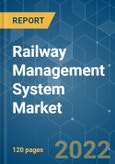The railway management system market is expected to reach a CAGR of 12% during the forecast period (2021 - 2026). Global trends, such as digitization, automation technologies to enhance optimization, government initiatives, connectivity, sustainability, energy conservation, and integration of IoT, are expected to be the major factors for the growth of the market.
Key Highlights
- Railway 4.0, also known as Digital Railway, is a major trend that leads to the automation of railway operations, is boosting the growth of the market. Moreover, the railway industry embraces disruptive technologies such as the Internet of Things (IoT), Artificial Intelligence (AI), big data analytics, cloud computing, and cybersecurity, which are likely to contribute to the growth of the market.
- The global population is expected to reach 9.8 billion by 2050, out of which 75% will dwell in cities. Hence, it has become imperative for public agencies to ensure that the transportation sector, specifically the rail network, is ready to meet the growing connectivity needs. Moreover, the emerging trend of smart cities is also boosting the railway management system market.
- The growth of the railway management system is expected to be primarily driven by the growing need for urban connectivity, increased integration of IoT- based solutions, and higher emphasis on reducing emissions.By 2050, it is expected that passenger mobility will increase by 200-300%, and freight activity will increase by 150-250%.
- Integration of the smart systems to communicate across traditional railway infrastructure, high investment in the development of software portfolio, minimizing error rates due to increasing system complexity and implementation of weatherproof sensors are identified as the major challenges faced by the market.
- Due to the ongoing COVID-19 outbreak, the automotive & transportation industry is amongst the most affected vertical and is facing huge losses due to lockdown across the world. Therefore the growth of the market is likely to fall till the resurgence of the industry.
Key Market Trends
Passenger Information System to Drive the Market Growth
- A passenger information system is likely to drive the growth of the market, as this is the most important communication link between transportation administrators and travelers, which provide visual and acoustic data to travelers on a route.
- PIS comprises constant train following, course data and booking, travel arranging, travel planning, and online connectivity solutions and is likely to grow over the forecast period due to the increase in passenger traffic and digitalization in the railway industry.
- For instance, in 2018, the Norwegian government started a project for complete digitalization of signaling and interlocking on the whole of the 4,200 km rail network in Norway, which is scheduled to be fully equipped with ERTMS by 2034.
Asia-Pacific to Witness Highest Growth
- Asia-Pacific is expected to account for the highest growth due to the rising adoption of new technologies and high investments for digital transformation. Moreover, the increasing GDP of countries such as Australia, Singapore, China, Korea, Hong Kong, and India further boost market growth.
- India, one of the fastest-growing economies in the world, is actively investing in the further development of its railway services. The country's railway ministry allocated a budget of USD 22.4 billion to develop the Indian railway network for the 2020-21 financial year.
- With this, India aims to reduce fatalities, prevent derailment by the installation of online monitoring of rolling stock, implementation of ERP, wireless corridor, heavy-haul trains specializing in the freight business, and development of specialized R&D Center.
Competitive Landscape
The railway management system market is moderately fragmented. Players in the market adopt strategies like innovations in their product, strategic partnerships, mergers, and acquisitions, and others to expand their market share. Some of the key developments in the area are:
- In November 2019, Alstom SA signed a second ten-year maintenance contract for ETCS equipment belonging to SBB, the Swiss national railway company. This contract extension is aimed to ensure the availability of spare parts and the large SBB fleet for the smooth operation of rail traffic in Switzerland.
- In April 2019, IBM partnered with Sund & Bælt, which owns and operates some of the largest infrastructures. This collaboration can assist in IBM's development of an AI-powered IoT solution designed to help prolong the lifespan of aging bridges, tunnels, highways, and railways.
Additional Benefits:
- The market estimate (ME) sheet in Excel format
- 3 months of analyst support
This product will be delivered within 2 business days.
Table of Contents
Companies Mentioned (Partial List)
A selection of companies mentioned in this report includes, but is not limited to:
- General Electric Company
- ABB Limited
- Alstom SA
- Cisco Systems Inc.
- IBM Corporation
- Hitachi Limited
- Huawei Technologies Co. Ltd.
- Siemens AG
- Indra Sistemas SA
- Alcatel-Lucent Enterprise
- Thales Group
Methodology

LOADING...








